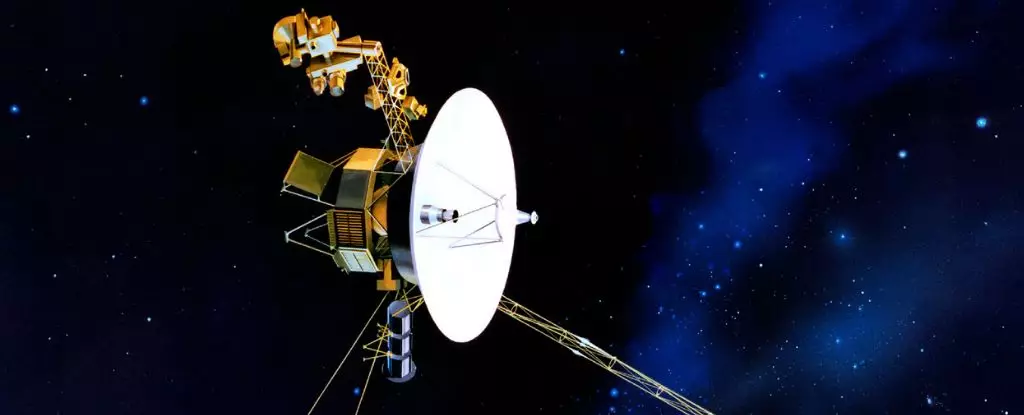Launched in 1977, NASA’s Voyager spacecraft have long been at the forefront of space exploration. With Voyager 1 and Voyager 2, humanity embarked on an unprecedented journey that would push the boundaries of our understanding of the solar system. These two emissaries, fueled by the decay of plutonium isotopes, have traveled billions of kilometers away from Earth, venturing into the unknowns of interstellar space. However, as time marches on, the power that sustains these remarkable craft is diminishing, prompting critical operational decisions regarding their scientific equipment.
In a recent announcement, NASA revealed that due to the declining energy reserves onboard Voyager 2, the plasma science instrument would be deactivated. This instrument, pivotal in measuring the quantity and direction of ionized particles in interstellar space, has been a key player in understanding the dynamics of space beyond our solar system. While Voyager 2 still possesses enough power to run four of its other instruments—namely a magnetometer and a particle detector—the gradual decline in available energy raises serious concerns about the spacecraft’s operational longevity.
Engineers have dedicated years to manage power consumption, in hopes of maintaining as much scientific capability as possible amidst dwindling resources. The urgency of retaining observational capacity cannot be overstated, particularly given that these spacecraft are the first and only to traverse the void beyond the heliosphere—the protective bubble created by the solar wind.
The Interstellar Frontier
Voyager 1 marked its entry into interstellar space on August 25, 2012, followed by Voyager 2 on November 5, 2018. These milestones hold monumental significance; they unlocked a new frontier of exploration and enriched our comprehension of the interstellar medium. Following their launch, which cleverly took advantage of a rare planetary alignment, the Voyagers conducted gravity-assist flybys of the gas giants Jupiter and Saturn, followed by the ice giants Uranus and Neptune. Voyager 2 remains the only spacecraft to have visited these distant ice worlds, offering a unique insight into their properties.
The dual missions not only documented remarkable findings but also provided crucial imagery that reshaped our perceptions of the outer solar system. As such, their current phase—the Voyager Interstellar Mission—focuses on the boundaries of the heliosphere and the behavior of cosmic phenomena in space unbound by the solar wind. Their explorations of this still-mysterious region embody a race against time, as scientific readiness is gradually eclipsed by energy limitations.
Confronting Energy Limitations
Voyager spacecraft are powered by radioisotope thermoelectric generators (RTGs), which convert heat from decaying plutonium into electrical power. These generators initially produced around 470 watts but lose an estimated 4 watts per year. At this rate, the Voyager team has had to make tough choices about which instruments to keep operational, turning off non-essential systems to conserve energy for data collection and communication.
The plasma science instrument’s deactivation reflects a broader trend of resource management faced by the mission team. Originally designed to explore the gas giants, many of the instruments became redundant after the missions transitioned to studying interstellar space. Prior to the shut-down decision, this plasma instrument operated on a limited basis, measuring interstellar plasma only as Voyager 2 adjusted its orientation relative to the Sun.
Despite the challenges posed by dwindling power, the Voyagers’ long-lasting impact on science is undeniable. Over 45 years, the data captured has provided unprecedented insights into solar and cosmic phenomena. However, as the spacecraft continue their journey through interstellar space, the slow withdrawal of functional instruments raises the concerning prospect of returning to a state of silence.
NASA’s attempts to preserve operational capabilities have been commendable; nonetheless, the impending reality remains stark—the scientific missions of the Voyager spacecraft are inherently finite. While aimed at delaying inevitable shutdowns, decisions made today will determine how much longer we can glean information from these distant travelers.
The Voyager spacecraft serve as a testament to human curiosity and ingenuity. Their operations are a poignant reminder of the transient nature of technology and the race against time inherent in space exploration. As the final operational instruments power down over the years, the legacy of these remarkable missions will inevitably persist, illuminating humanity’s reach into the cosmic unknown.

